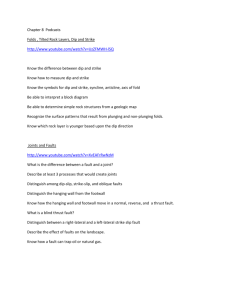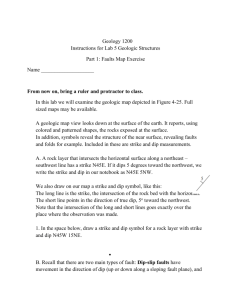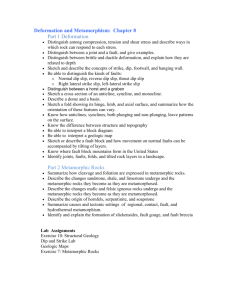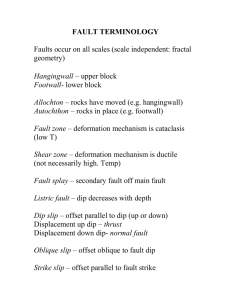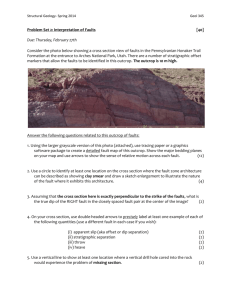Chapter 5 Faults - San Diego State University Department of
advertisement
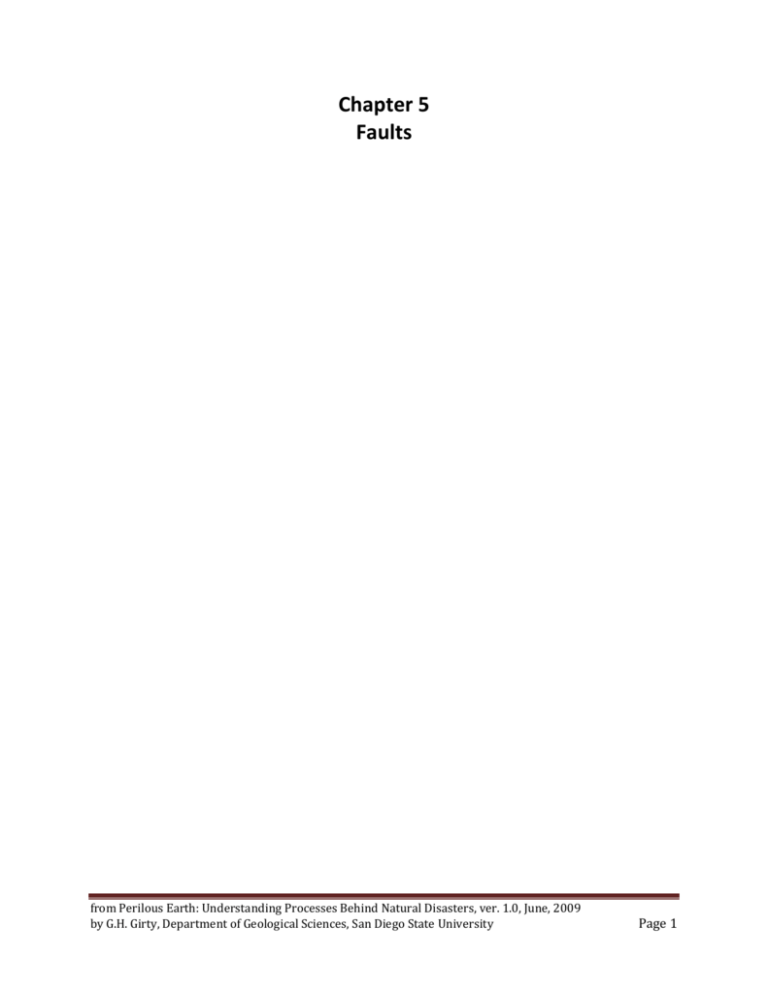
Chapter 5 Faults from Perilous Earth: Understanding Processes Behind Natural Disasters, ver. 1.0, June, 2009 by G.H. Girty, Department of Geological Sciences, San Diego State University Page 1 Introduction Faults are surfaces across which Earth material has lost cohesion and across which there is perceptible displacement (Figure 1). Though the faults that we will focus on in this chapter have experienced multiple slip events, and, as result of those events have accumulated displacements of kilometers to hundreds of kilometers, faults with displacements as small as a few millimeters or so are also rather common. In addition, though many faults break the Earth’s surface, others do not. These latter structures are called blind faults. Figure 1. Aerial view of San Andreas fault, Carrizo Plains, California. Photograph by R.E. Wallace, United States Geological Survey (Open‐File Report 83‐98). The attitude of a fault describes its orientation in 3D space, and consists of its strike and its dip. The strike is the direction of a line produced by the intersection of the fault surface and an imaginary horizontal plane (Figure 2). In contrast, the dip is the angle between an imaginary horizontal plane and from Perilous Earth: Understanding Processes Behind Natural Disasters, ver. 1.0, June, 2009 by G.H. Girty, Department of Geological Sciences, San Diego State University Page 2 Figure 2. The attitude of a fault surface is its strike and dip. The direction of the line produced by the intersection of the fault surface with an imaginary horizontal plane is the strike while dip is the angle between the imaginary horizontal plane and the fault surface. the fault surface. If the dip is 90o, then the fault has a vertical dip. At the other end of the spectrum, if the dip is 0o, then the dip is horizontal. There is immense pressure forcing the two blocks on opposite sides of a fault surface together. In addition, the faults surface is not smooth but instead is highly irregular and covered with fractions to millimeter high ridges called asperities. During a slip event these asperities carve grooves into the fault surface. These grooves are called slickenlines and they track the slip direction (Figure 3). Figure 3. Slickenlines lying in a fault surface track the slip direction. In the illustrated example, a fault surface is exposed in a ravine. The block that should be in the foreground has been eroded away. The geology student is standing where the foreground block was prior to erosion. In contrast, the block lying in back of the fault surface is clearly visible. The nearly horizontal orientation of the slickenlines in the fault surface indicate that the blocks on opposite sides of the fault surface slide horizontally past each other parallel to the slickenlines. Hence, the fault was strike‐slip. Unfortunately, the absence of any piercing points does not allow us to say if the motion was right‐lateral or left‐lateral. The attitude of the fault is important because it is used to classify the fault as either dip‐ or strike‐slip. For example, if the displacement across the fault is parallel to strike, then the fault is a strike‐slip fault (Figure 4). On the other hand, if the displacement is parallel to the dip and at right angles to the strike, then the fault is a dip‐slip fault (Figure 5). However, sometimes the displacement is neither parallel to the strike nor to the dip, and, in such cases the fault is classified as an oblique‐slip fault (Figure 6). from Perilous Earth: Understanding Processes Behind Natural Disasters, ver. 1.0, June, 2009 by G.H. Girty, Department of Geological Sciences, San Diego State University Page 3 Figure 4. Strike‐slip fault. A row of stones and grass are displaced by a fault with a north strike (red line lying in horizontal plane) and a vertical dip. The arrows are the conventional geological symbol for showing the slip direction. Note that the displacement across the fault is parallel to the strike of the fault surface. Figure 5. Dip‐slip fault. A row of stones and grass is displaced by a fault with a north strike (red line lying in horizontal plane) and an ~60 eastward dip. The arrows are the conventional geological symbol for showing the slip direction. Note that the displacement across the fault is parallel to the dip direction, i.e., at right angles to the strike of the fault surface. from Perilous Earth: Understanding Processes Behind Natural Disasters, ver. 1.0, June, 2009 by G.H. Girty, Department of Geological Sciences, San Diego State University Page 4 Figure 6. Oblique‐slip fault. A row of stones and grass is displaced by a fault with a north strike (red line lying in horizontal plane) and an ~60 eastward dip. Note that the displacement (i.e., the slip direction) across the fault is neither parallel to the dip direction nor to the strike direction. There are two types of strike‐slip and two types of dip‐slip fault. The two types of strike‐ slip fault are right‐lateral (or dextral) and left‐lateral (or sinistral) while the two types of dip‐ slip fault are normal and reverse (or thrust) (Figure 7). In general, strike‐slip faults tend to have dips that are near vertical while dip‐slip faults tend to dip about 60o for normal and 30o for reverse or thrust faults. For dip‐slip faults, the block lying on top of the fault surface is referred to as the hanging wall while the one below is referred to as the footwall block (Figure 7). In order to classify a strike‐slip fault you must first identify some linear feature that is transected by the fault. The location where this feature pierces the fault surface is called the piercing point (Figure 7). For the large faults that we will consider in this class, common linear features might include streams (see Figure 1), railroads, roads, and fences. If the strike‐slip fault is right lateral, then when you walk down the offset linear feature toward the fault surface, upon reaching the piercing point you will have to turn to your right and then walk down the fault trace to find the continuation of the offset linear feature. Try this technique for the right‐lateral strike‐slip fault shown in Figure 7. Imagine that you have walked completely from one end of the road to the piercing point, and then along the trace of the fault to the other half of the offset road, and then finally to the distant end of the road. Now imagine turning around and walking back toward the fault. Upon reaching the piercing point, note again that you have to turn to the right to reach the offset road. In short, when classifying a fault it does not matter which side you approach the fault from. Again, use Figure 7 and verify for yourself that for a left‐lateral strike‐slip fault, upon reaching the piercing point, you will have to turn to the left to find the offset linear feature (Figure 7). The first step in classifying dip‐slip faults is to identify the hanging and footwall blocks. After completing this task, simply note that in normal faults the hanging wall moves down relative to the footwall while for reverse or thrust faults the hanging wall moves up (Figure 7). from Perilous Earth: Understanding Processes Behind Natural Disasters, ver. 1.0, June, 2009 by G.H. Girty, Department of Geological Sciences, San Diego State University Page 5 Figure 7. Block diagrams illustrating the major classes of strike‐slip and dip‐slip fault. Oblique‐slip faults are classified on the basis of which of the two major components, strike‐ or dip‐slip dominate (Figure 8). If the strike component dominates, then the fault would be classified as either an oblique right‐lateral or an oblique left‐lateral strike‐slip fault depending upon if the slip is dextral or sinistral respectively (Figure 8). If on the other hand, the dip component dominates, then the fault would be classified as either an oblique normal or an from Perilous Earth: Understanding Processes Behind Natural Disasters, ver. 1.0, June, 2009 by G.H. Girty, Department of Geological Sciences, San Diego State University Page 6 oblique reverse fault depending upon if the hanging wall moved down or up relative to the footwall block respectively. Figure 8. Bock diagrams of the major classes of oblique‐slip faults. The illustration shows slickenlines in light gray lying parallel to the slip vector, the actual direction and magnitude of displacement. When the strike‐slip component of this vector is longer than the dip‐slip component then the fault is an oblique strike‐slip fault. On the other hand, if the dip‐slip component of the slip vector is longer than the strike‐slip component, then the fault is an oblique dip‐slip fault. The distribution of the various classes of faults is controlled in large part by plate tectonic setting. For example, reverse and thrust faults are common structures along convergent margins, while strike‐slip faults are characteristic of transform plate margins. In contrast, normal faults commonly dominate where continental plates are splitting apart (e.g., the East Africa Rift) and along mid‐ocean ridges. from Perilous Earth: Understanding Processes Behind Natural Disasters, ver. 1.0, June, 2009 by G.H. Girty, Department of Geological Sciences, San Diego State University Page 7 In the above settings, as a result of continuous plate motion, the rocks in and around plate boundaries are constantly under stress. When this stress (i.e., force/area) exceeds the strength of the rock along a segment of a particular type of boundary, then it fails, rupturing brittlely along a plane of failure and a new fault is formed or slip on an old fault takes place. Let’s take a closer look at how this process works. Brittle Failure of Rock In order to understand what makes a rock break, you need to have a basic understanding of forces and stresses. A force is a vector because it has a magnitude and a direction. Forces that act on every point within a given body of Earth material are called body forces. In contrast, those that act on specific surfaces are called surface forces. Gravity tends to pull all bodies on the surface of the Earth towards its center, and is therefore a body force. For example, if you jump off a 5 meter cliff into a lake, the falling sensation that you feel is entirely due to gravitational forces pulling you toward the center of the Earth. Though a similar sensation is achieved on a large water park slide, the results are instead due to surface forces acting on the relatively frictionless interface between your body and the underlying slide. The position of a given body of rock can be changed by accelerating the entire body through either the application of a surface or body force. However, if the intensity of the force being applied across the body of rock varies, then acceleration of the various parts of the body would be unequal, and as a result the shape of the body would change, i.e., become distorted. A distortion or change in shape is referred to as strain while a measure of the intensity of the applied force is stress. Stress is defined as force per unit area, or in equation form as = force/area, where (sigma) represents stress. The units of force are the Newton (N); the units of stress are therefore Newtons per square meter (N/m2). Geologists commonly convert N/m2 to other easier to use units of stress such as bars, kilobars (kbar), Pascals (Pa), and megaPascals (MPa). These latter units are interrelated in the following manner: 1 kbar = 1000 bars, 1 bar = 100,000 Pa, and 1 MPa = 1,000,000 Pa. When rocks in the upper part of the crust (those above about 15 km depth) are stressed, they respond by distorting (straining). However, if the load is removed (i.e., the stress is removed), then they return to their original shape and volume. When a rock responds to stress in this manner, it is said to behave elastically. When a body of rock is elastically distorted it contains stored up elastic strain energy. As an analogy, consider a common day elastic material, a rubber band. If you stretch the rubber band between your two hands, then in this configuration the rubber band contains stored up elastic strain energy. If you release the rubber band from one of your hands, then as stored up elastic strain energy is released, the rubber band automatically snaps back in place regaining its original form and shape. If we continue to increase the stress on an elastic rock, then at some point in time the stress will reach a critical value, and the rock will fail (i.e., break). When this happens along a plate boundary either a new fault will form or slip will occur on an old fault. In most cases, the from Perilous Earth: Understanding Processes Behind Natural Disasters, ver. 1.0, June, 2009 by G.H. Girty, Department of Geological Sciences, San Diego State University Page 8 latter is the result, and the critical stress value at which the fault ruptures (slips) is called the maximum or static stress. Immediately following the slip event there is a drop in the stress value along the fault. However, because plate boundaries are always areas that are loaded (i.e., under stress), the stress immediately begins to build up along the fault, and over time the fault will again fail when the static stress value is reached. Hence, faults stick during intervals of low stress and slip when the stress climbs to the static value. This general behavior is called stick‐slip and along plate boundaries it is characteristic of all faults in the upper crust. When a fault ruptures it gives off heat and seismic energy in the form of seismic waves. These waves produce a vibration and shaking of the Earth’s surface that is an earthquake. In short, there is a direct tie between faults and earthquakes as the former are responsible for the latter. Summary Faults are ubiquitous structures of the Earth. They are the source of earthquakes which can cause severe damage to homes and even death. It is important that you, a citizen of planet Earth, have a basic understanding as to why faults form. If you have completed this chapter, then you should understand that faults within the Earth's crust are the result of the failure of rock or slip on an existing fault under some applied natural load. Along plate boundaries, this load is supplied by the motion of plates which in turn is driven by heat escaping from the interior of the planet. Prior to rupture rocks build up elastic strain energy. During the rupture process a stress drop occurs and the built up elastic strain is released as heat and seismic waves. As discussed in the next chapter it is these seismic waves propagating outward from the site of rupture that generates the earthquakes that we are all so familiar with. In California, as well as many other seismically active regions of the world, belts of earthquakes tend to be centered on major fault systems, many occurring along plate boundaries. Some of these faults contain segments that are locked, while others are in creep mode. Locked segments have not slipped in some time and as a result have not generated seismic activity. Along locked segments, strain energy will continue to be stored until eventually the static stress value is reached and slippage will occur. In contrast, creeping segments indicate that strain is constantly being released through slippage. Due to the inability to store large amounts of elastic strain energy, large earthquakes do not commonly occur along creeping segments of faults. Though faults commonly break through to the surface of the Earth, some do not, remaining deeply buried. References Used in the Development of this Chapter Books and Papers Twiss, R.J., and Moores, E.M., 2007, Structural Geology, 2nd Edition, W.H. Freeman and Company, New York, 736 p. Web sites http://earthquake.usgs.gov/learning/glossary.php from Perilous Earth: Understanding Processes Behind Natural Disasters, ver. 1.0, June, 2009 by G.H. Girty, Department of Geological Sciences, San Diego State University Page 9
